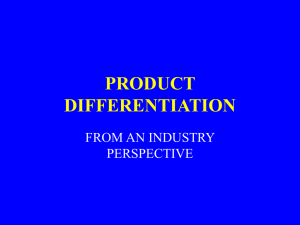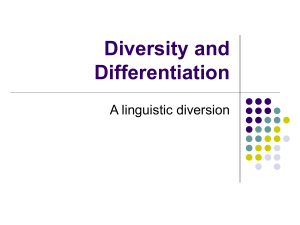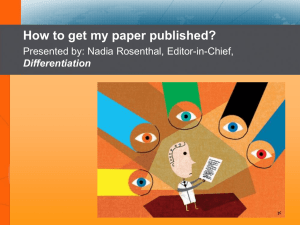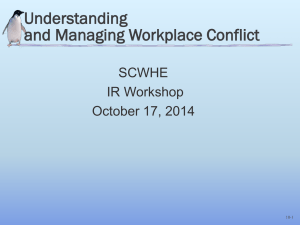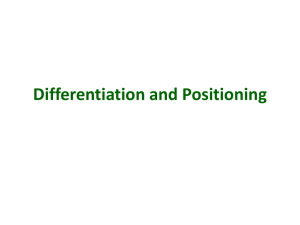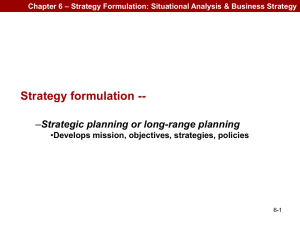(Regional) Marketing Plan
advertisement
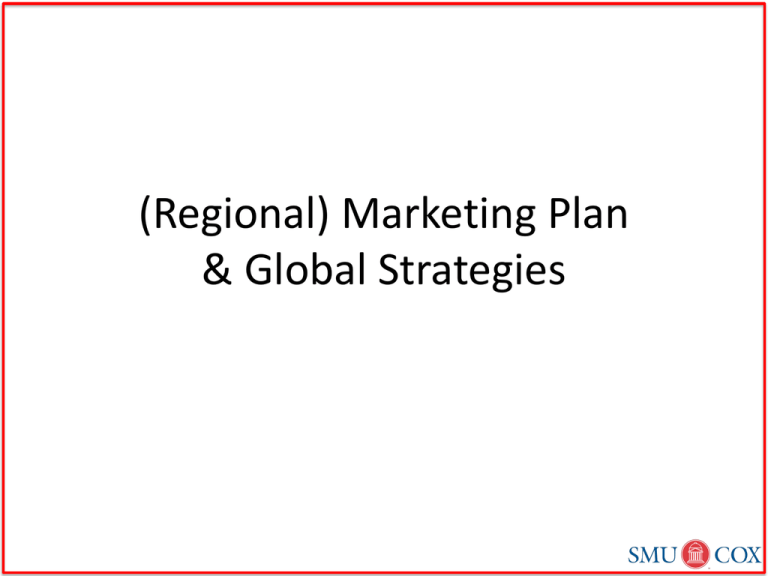
(Regional) Marketing Plan & Global Strategies Things to Keep in Mind • Set your competitive advantage & regional strategy first • Overall strategic framework drives country-level decisions Business Strategy Competitive Advantage The unique position a firm develops through resource & capability deployments that leads customers to choose the firm’s products over competitors. Advantage can be based on: • Cost Leadership (Low cost & price); • Product Differentiation – offering superior economic value by creating superior product/service features & quality through innovation & product development capabilities; • Marketing Differentiation – offering superior perceived value by developing – Unique image (brand-centric differentiation) achieved through targeting, positioning & communication capabilities – Close relationships with customers (customer-centric differentiation) achieved through CRM capabilities & customization Things to Keep in Mind Regional Marketing Plan • Set your competitive advantage & regional strategy first • Overall strategic framework drives country-level decisions • Plan for the long-term • Decisions 1-3 = focus on awareness, gaining distribution • Decisions 3-5 = build market share • Decisions 6+ = now aim to be profitable Marketing Plan Due • Recognize regional strategic issues • Trade agreements • Standardization vs. Customization • Don’t forget the basics! • 4Ps – Product, Price, Promotion, Place • Competition Marketing Plan • A marketing plan is a written document that details the necessary actions to achieve one or more marketing objectives. • A marketing plan is a business document written for the purpose of describing the current market position of a business and its marketing strategy for the period covered by the marketing plan. Marketing plans usually have a life of from one to five years. • Purpose of a Marketing Plan: The purpose of creating a marketing plan is to clearly show what steps will be undertaken to achieve the firm’s marketing objectives. Marketing Plan Length & Organization • The Marketing Plan should be 24-30 paragraphs of text (see the Marketing Plan Grade Sheet). Singlespaced, that probably translates to around 10 pages. I expect there could be another 10-20 pages of exhibits, depending on formatting. Please follow the order suggested in the CM Marketing Plan and in the Marketing Plan Grade Sheet. Suggestions • Following the Grade Sheet: – Break the document up and allocate sections to individuals or small teams – For each section, envision and create 1 or more exhibits – Then write the section, making use of the exhibits – Integrate each section into the final document, numbering & organizing exhibits – Then write the Executive Summary Four Major Sections and Possible Exhibits Situation Analysis – Country Attractiveness & SWOT exhibit for each target country incorporating current customer & competitor information Strategic Development – Regional Marketing Plan & Positioning Map for each country incorporating current competitor and BEI information Marketing Objectives – Volume Forecast for each country (Last year’s and next 2 years) Marketing Mix -- Country x year action plan (Last year’s and next 2 years): Product volume & Benefit Positioning, price & Price Positioning, distribution channels & Penetration, sales staff & Sales per Salesperson, promotion levels & BEI, etc. Competitive Advantage in Emerging Markets See Global Giants reading Regardless of being an established or emerging MNC, the cost advantage is disappearing and the game is changing. Established MNC's can destroy an emerging MNC's local cost advantage & cause them to improve & adjust. A good example of this is TATA. IBM and Accenture pay more for the talent in India & cause Tata to adjust & raise its costs. In China, Nokia expanded production facilities and neutralized Ningbo Bird's cost advantage. The point is that a "cost leader" strategy is not much of a competitive advantage when it comes to the battle between emerging and established MNC's. Product Differentiation, Marketing Differentiation, Cost Leadership Rearrange Value Chain, Emerging Segments, Converging Cost Structures CM Local CM Global & Regional Competitors Competitor s Competitive Advantage Distribution Selective Mid quality Mid quality product product Exclusive High quality product X X X X Mid price X Marketing Differentiation X X Low price Cost Leadership X X X High price X X Product Differentiation Heavy Low price Light Advertising & Promotion Wide Low quality product Aquafresh X Aquafresh French Aquafresh Argentina Crest HK Product Differentiation – Marketing Differentiation Local Growth Team Model (GE) Emerging-Market Success 1.Shift power to where growth is (Rearrange value chain) 2.Build new offerings from ground up (Zero-based innovation) 3.Build LGTs from ground up (Zero-based design) 4.Customize objectives, targets & metrics 5.LGT reports to someone high up 1.Participate in Mass Market (for scale) 2.Localize 4 Ps 3.Manage costs 4.Build local team 5.Acquire selectively (to broaden distribution & create low-cost structure) 6.Stay the course See How to Win Emerging Markets Regional Marketing Plan


